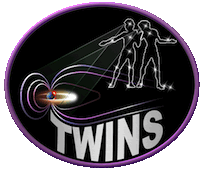The TWINS Mission
 Two Wide-angle Imaging Neutral-atom Spectrometers (TWINS) is a NASA Explorer Mission-of-Opportunity to stereoscopically image the Earth's magnetosphere for the first time. TWINS extends our understanding of magnetospheric structure and processes by providing simultaneous Energetic Neutral Atom (ENA) imaging from two widely separated locations. TWINS observes ENAs from 1-100 keV with high angular (~4°x4°) and time (~1-minute) resolution. The TWINS Lyman-alpha monitor measures the geocoronal hydrogen density to aid in ENA analysis while environmental sensors provide contemporaneous measurements of the local charged particle environments. By imaging ENAs with identical instruments from two widely spaced, high-altitude, high-inclination spacecraft, TWINS enables three-dimensional visualization of the large-scale structures and dynamics within the magnetosphere for the first time.
Two Wide-angle Imaging Neutral-atom Spectrometers (TWINS) is a NASA Explorer Mission-of-Opportunity to stereoscopically image the Earth's magnetosphere for the first time. TWINS extends our understanding of magnetospheric structure and processes by providing simultaneous Energetic Neutral Atom (ENA) imaging from two widely separated locations. TWINS observes ENAs from 1-100 keV with high angular (~4°x4°) and time (~1-minute) resolution. The TWINS Lyman-alpha monitor measures the geocoronal hydrogen density to aid in ENA analysis while environmental sensors provide contemporaneous measurements of the local charged particle environments. By imaging ENAs with identical instruments from two widely spaced, high-altitude, high-inclination spacecraft, TWINS enables three-dimensional visualization of the large-scale structures and dynamics within the magnetosphere for the first time.
History
The feasibility of magnetospheric imaging using energetic neutral atoms (ENAs), which arise from the charge-exchange process between cold geocoronal neutral hydrogen and the local energetic ion populations, was first demonstrated two decades ago (Roelof 1987). Technologies were then developed to provide higher sensitivity, better angular resolution, and, most importantly, to extend the observable ENA energy range below several tens of keV, down to ~1 keV (McComas et al. 1991, 1998). High energy neutral atom images from NASA's Polar spacecraft provided some of the first tantalizing glimpses of the power of neutral atom imaging (Henderson et al. 1997).
The IMAGE (Burch 2000) mid-sized Explorer was NASA's first dedicated platform for making ENA measurements of the Earth's magnetosphere. IMAGE, launched on March 25, 2000, was developed by a team of researchers led by TWINS Co-Investigator, Dr. J. Burch. IMAGE has provided a full range of ENA observations of the magnetosphere with three complimentary ENA imaging instruments spanning energies from 1-500 keV. A broad spectrum of scientific studies have used these observations and demonstrated the power of ENA imaging in understanding our dynamic magnetosphere, including substantial contributions to the understanding of magnetospheric substorms and storms.
TWINS is extending our understanding of magnetospheric structure and processes beyond what was achieved via IMAGE by providing simultaneous images from two widely separated locations over a broad ENA energy range. TWINS began stereo imaging in June 2008, and since then has observed numerous CIR-driven storms. Stereo imaging is yielding substantial progress in our characterization of the global three-dimensional distribution of the ring current.
Orbits
 TWINS flies as a mission of opportunity on two high-inclination, high altitude spacecraft provided by a non-NASA US government organization. Each spacecraft is 3-axis stabilized and approximately nadir pointing, and is placed in a Molniya orbit with 63.4° inclination and 7.2 RE apogee, an ideal orbit for magnetospheric imaging. TWINS began its stereo imaging mission in June 2008.
TWINS flies as a mission of opportunity on two high-inclination, high altitude spacecraft provided by a non-NASA US government organization. Each spacecraft is 3-axis stabilized and approximately nadir pointing, and is placed in a Molniya orbit with 63.4° inclination and 7.2 RE apogee, an ideal orbit for magnetospheric imaging. TWINS began its stereo imaging mission in June 2008.


